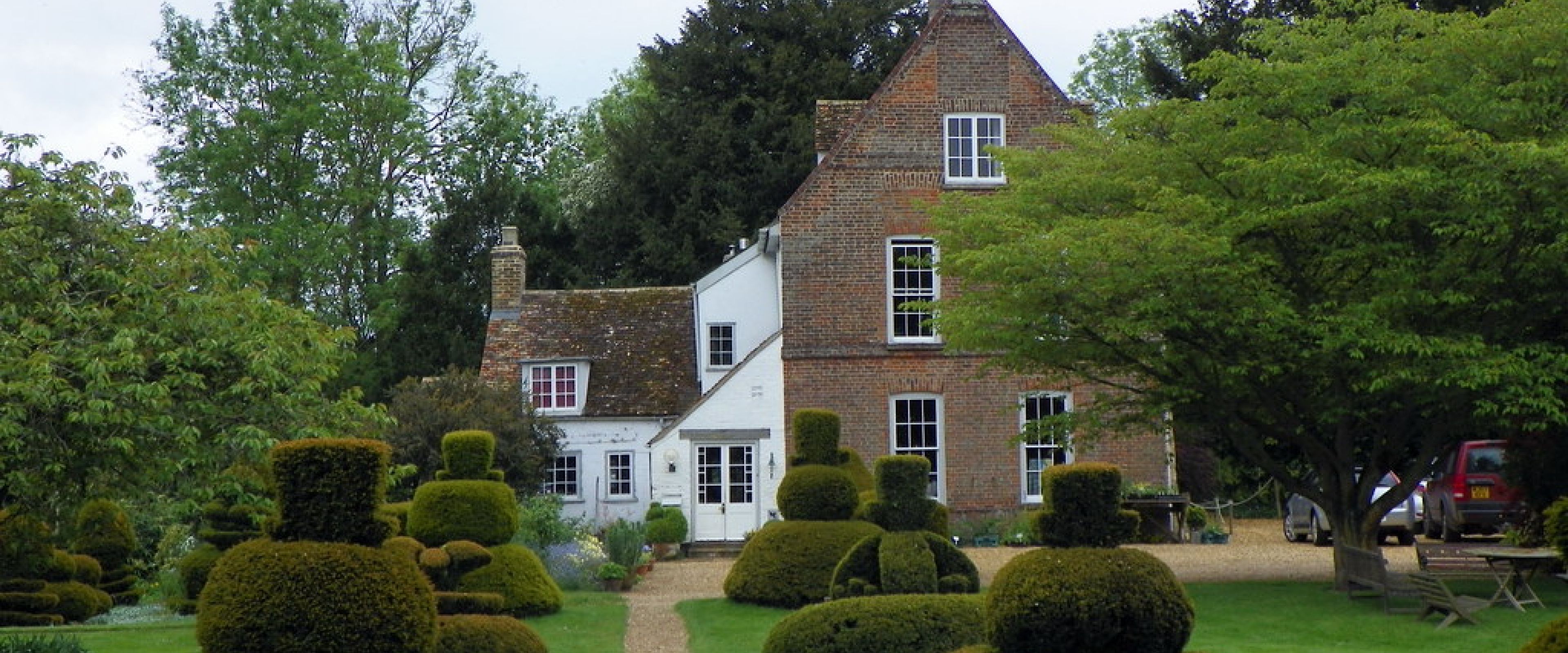The beloved tales of Green Knowe had the most beautiful inspiration for the setting, Manor Hemingford Grey. Old roses, rare irises and enchanting topiary fill the stories and gardens with a special kind of magic.
Itinerary/Excursions
Manor Hemingford Grey
The Manor, Manor Hemingford Grey, is a house in the village of Hemingford Grey, Cambridgeshire. Built about 1130 by Payn Osmundsen, tenant of Aubrey de Vere. 1256 – 1490 owned by the de Grey family then, amongst others, Edmund Dudley, Henry VII’s favourite and Richard Cromwell, Oliver’s grandfather. Lucy Boston bought the house in 1939 and restored it, as much as possible, back to its Norman original. None of Lucy’s predecessors at The Manor had given much time to the garden so it was more or less two fields. During the war years she planted mostly trees and shrubs. As a child she was fascinated by the topiary at Levens’ Hall so she planted eight 10” high yew plants on either side of the path to the river. These became cones and then for the Queen’s coronation she clipped them into crowns, orbs and the dove of peace from the old sceptre. After the war she started to garden in earnest, collecting old roses and irises with the help and advice of Graham Stuart Thomas. Now in the front garden we have a meadow patch with fritillaries followed by marsh orchids. The herbaceous borders are filled with plants to flower throughout the seasons.
Island Hall - Guided Tour
Island Hall is an important mid-18th century mansion, located on the banks of the Great Ouse in the centre of Godmanchester. This family home has Georgian rooms with fine period detail and interesting possessions relating to the owners’ ancestors since their first occupation of the house in 1800. Godmanchester was, in Roman times, a major settlement at an important crossroads and became one of England’s earliest boroughs when it was awarded its charter in 1212. Island Hall has approximately one and a half acres of formal garden with a large river frontage and a further two-acre ornamental river island – from which the Hall takes its name – linked to the mainland by a Chinese bridge. The house enjoys hosting visitors, not only to support this historic building, but also to share the house and grounds with great pride. The guided tours feature the ground floor rooms of the house, plus three first floor rooms and a guided tour of the grounds.
Cambridge - Fitzwilliam Museum - University of Cambridge Botanical Garden
The city of Cambridge is located on the River Cam and became an important trading centre during the Roman and Viking ages and there is archaeological evidence of settlement in the area as early as the Bronze Age. The city is well known as the home of the University of Cambridge, which was founded in 1209 and consistently ranks among the best universities in the world. The Fitzwilliam Museum is the lead partner of the spectacular collections of the University of Cambridge Museums and Botanic Garden. From antiquity to the present day, the Fitzwilliam houses a world-renowned collection of over half a million beautiful works of art, masterpiece paintings and historical artefacts. Cambridge University Botanic Garden holds a collection of over 8,000 plant species from all over the world to facilitate teaching and research. The Garden provides resources including plant material, horticultural expertise and facilities to research workers and lecturers. Since its foundation, however, the Garden has also provided a beautiful place for everybody to enjoy and benefit from – a series of wonderful landscapes through which to discover the drama of plant diversity.
Wimpole Estate and Gardens NT
Wimpole Estate is a large estate containing Wimpole Hall, a country house located within the civil parish of Wimpole, Cambridgeshire. The house, begun in 1640, and its 3,000 acres of parkland and farmland are owned by the National Trust. Step inside Wimpole Hall and explore the rich history of the Hall. Wimpole’s interior is a rich mixture of mainly 18th-century decoration, including a spectacular Baroque chapel with trompe l’oeil murals by Thornhill and a library designed by Gibbs for Edward Harley, Earl of Oxford. Explore the gardens at Wimpole where iconic garden and landscape designers including Charles Bridgeman, Robert Greening, Lancelot ‘Capability' Brown and Humphry Repton have all left their mark.
Anglesey Abbey NT
Anglesey Abbey is a National Trust property in the village of Lode, near Cambridge. The property includes a country house, built on the remains of a priory, 98 acres of gardens and landscaped grounds and an eighteenth-century working watermill with three floors of traditional machinery and history to explore. The priory was closed in 1536 during the dissolution of the monasteries and a Jacobean-style house was built on the site of the ruins in about 1600. The last private owner was Lord Fairhaven who lived in the house from 1926 until he died in 1966. He made extensive additions to the house to accommodate his collection of furniture, art, books and objets d'art and landscaped the grounds. On his death, he left the house and its contents to the National Trust.
Your holiday includes
- 4 nights at the Huntingdon by Delta Marriott
- Breakfast and all evening meals
- Manor Hemingford Grey
- Guided tour of Island Hall
- Entry to NT properties if member
- Fitzwilliam Museum and University of Cambridge Botanical Garden
- Private coach travel
- Services of an experienced driver
- 4 singles with no supplement
- Cancellation Protection
Hotel Details
4 nights at the Huntingdon by Delta Marriott







